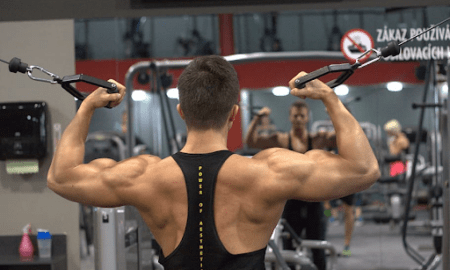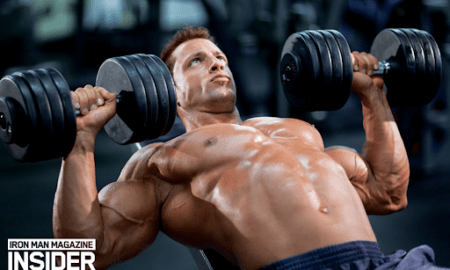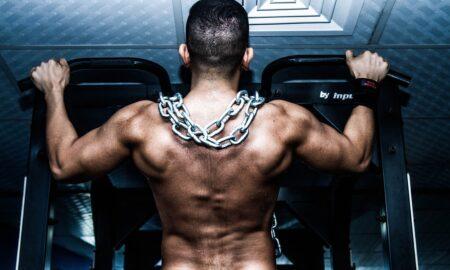Q: I first heard of you in the fall of 2005, when I attended your seminar at Michigan Tech, which is included on your new DVD “Natural Bodybuilding Seminar and Competitions.” By following your advice, I’ve improved my physique considerably. Here’s my dilemma: When I first started training, I concentrated on shoulders and arms, and they’ve always developed well. I was lacking a back until I read your book, and now that has drastically improved; however, I’m having a trouble with my lower chest. Could it be that by neglecting my chest at the beginning, I hampered my chest development? I have success with upper chest, and I can bench dumbbells with much more weight on an incline than a flat bench and really feel the burn. Also, when I flex my chest, I have much development in the upper portion. The bottom, however, especially the lower, outer portion, seems to be greatly lacking. I’ve tried everything from decline- to flat-bench dumbbell presses. It seems I never feel it the way I should in my lower chest. I’m 34, 5’7 1/2”, and I have 18-plus-inch arms and wide shoulders—and now I’m getting the back I want. I get a lot of comments on my build, but I want to get my lower chest in the game. Should I try going really light with high reps on a flat bench looking for a burn in the lower chest? There must be some way to target the area more effectively.
A: Many bodybuilders have the opposite problem: Most struggle to build their upper pecs while the lower pecs seem to develop very easily. I think the reason for that is the popularity of the barbell bench press. If you bring the bar low on your chest, the lower pecs will feel most of the stress. Because the bench press is such a popular exercise, especially with the younger guys, many of them find they have very big and sometimes overdeveloped lower pecs after years of heavy benching.
You mentioned that you do decline presses and dumbbell bench presses to build your lower chest. Maybe you should add the barbell bench press if you don’t do it already. Make sure you use a moderately wide grip so you involve your chest more than your triceps during the execution of the movement. Keep your elbows wide, and lower the bar to the lower part of your chest so you use the bottom portion of your pecs to complete the exercise. I always get sore in my lower pecs from doing heavy barbell bench presses for five to eight reps. I don’t get that same soreness from dumbbell bench presses, no matter how heavy I train.
Another excellent exercise for the lower pecs is wide-grip dips. Find dipping bars that are wide at one end and grab them at the widest part. Bend your upper body at the waist so your torso is angled forward. Keeping your elbows wide, lower your upper body as far as you can. Push back up about two-thirds of the way to the top and then go back down for a full stretch. That range of motion will keep constant tension on your pecs and limit the use of your triceps. By leaning forward, you better activate the lower pecs.
The barbell decline presses you do are good for the lower pecs, but I prefer wide-grip dips. Declines always affect my front deltoids more than my lower pecs.
If decline presses aren’t building your lower pecs, try decline flyes instead. The flye movement will isolate the lower pectorals more, rather than bringing in the front deltoids and triceps, as the decline press does. In addition, you’ll get more of a peak contraction in the lower pecs at the top part of the decline flye.
Here are two routines for the chest that focus on your lower pecs:
Routine 1
Barbell bench presses 4 x 10, 8, 6, 6
Incline dumbbell presses 3 x 10, 8, 6
Decline flyes 3 x 10, 8, 8
Routine 2
Incline barbell presses 4 x 10, 8, 6, 6
Dumbbell bench presses 3 x 10, 8, 6
Wide-grip dips (weighted) 3 x 8, 6, 6
Q: I’m really happy to tell you that your advice has had a great impact on my physique. Here are my stats over a two-month period:
Weight: 173.25 to 191.25 pounds
Arms: 14.5” to 15.5”
Chest: 41.5” to 42”
I made all those muscle gains with no fancy supplements or steroids. My supplement stack consisted of ON Gold Standard Whey, and that’s it. I’ve used ON before, but the results came only after I applied your advice. I’ve noticed that due to the weight gain I’ve also added some fat, but none of it has hit my shoulders, arms, chest or legs. Now the questions:
1) The fat has accumulated around my waist, whereas my shoulders, arms, chest and legs are hard and muscular. Why is that?
2) I don’t want to do cardio because I want to keep my gains. How should I go about losing the fat?
3) I’m thinking of dieting down to reduce the fat deposits. Is that a sound strategy?
A: Congratulations on your very impressive gains. Adding almost 20 pounds of bodyweight and putting an inch on your arms is great. The increase in calories and carbs that I recommended is doing the job. As for your questions:
1) The first place we always gain fat is the waist, and it’s the last place it leaves. The fact that your other bodyparts are still hard and muscular is a good sign. It means you added some muscle to your frame too.
2) If you want to lose the fat, just cut back on your calories and your carbs, but only slightly. If you cut way back, you’ll lose your new muscle gains.
Begin by counting the calories, protein, carbs and fat you’re eating now. By knowing exactly what you’re taking in, you can make adjustments.
How many calories and carbs you need to gain weight and muscle size is always an individual thing. Everyone has different needs, based on metabolism, age, muscle mass and daily activity level, among other factors.
When I was 20 years old and trying to get bigger, I needed to eat close to 5,000 calories a day before I started to put on weight and gain size. I combined a high-calorie diet with a heavy training program, focusing on the basic exercises. You may not need as many calories as I did, though others may actually need more.
I suggest making the changes to your diet instead of adding cardio. If you continue your present diet and just add cardio, it will be difficult to lose fat. The extra calories you burn doing cardio will be quickly replaced by the food you eat. Just cut back on your calories and carbs and leave the cardio alone.
3) In my opinion, dieting down to reduce fat deposits is not a good idea. If you want to get bigger, keep doing what you’re doing. Keep eating a lot of food and keep training heavy so you continue to add muscle.
Some guys make the mistake of eating more calories but not pushing themselves in the gym to train heavier. If you’re eating more food, you need to train heavier and harder. Your main focus should be on getting stronger in the big lifts—squats, deadlifts, bench presses, incline presses, overhead presses, shrugs, barbell rows, close-grip bench presses, etc.
If you think you’re adding too much fat compared to muscle, cut back on your carb intake or cycle your carbs by eating fewer of them on your nontraining days. Make sure you are eating good, clean bodybuilding foods and not just junk.
To be honest, I never worried about adding a little fat when I was younger and trying to get bigger. The need to always have a six-pack is a 21st-century phenomenon based on all the marketing and advertising that glorifies hard physiques and six-pack abs.
If you want to get really big, you need to eat some excess calories and some excess carbs. You need to flood your body with those excess calories in order to put it in an anabolic, growing state. You’ll never get there—especially if you have a fast metabolism that discourages weight gain—if you’re watching every morsel you eat and are constantly worried about adding fat that might obscure your abs.
Your focus should be on getting bigger and bigger. You sound as if you’re on the right track because your shoulders, chest and arms are noticeably bigger and don’t seem any fatter. Just make sure you’re training harder and heavier—stronger muscles are bigger muscles—as you eat the high-calorie diet. By training big and eating big, you’ll get big. You can regain your coveted six-pack after you add some meat to the rest of your body.
Q: I’m a female who competes in both bodybuilding and figure. At showtime, I’m able to get down to 110 with relatively low bodyfat. The part I struggle the most with is my legs; everything else shreds up nicely. I’d been advised to not train my legs or do cardio the week before and the week of my competition. Is that correct for a woman? Especially since I hold bodyfat and/or water in my legs. It seems to me that cranking out cardio as a last-ditch effort would be the way to go. The female body is so different from the male body, and I haven’t been able to find an answer. What do you think is the proper path for women to follow leading up to competition day?
A: I agree with you that a woman’s body is very different from a man’s, especially when they’re preparing for a bodybuilding or figure competition. I’ve worked with several women who competed in both figure and bodybuilding, and the lower body is always the last area to get really lean. With men it’s usually the lower abs and lower back. With women it’s the legs and glutes.
I’ve always had the opposite problem with my legs. My thighs were my weakest bodypart when I was preparing for a contest, so I would continue to train them heavy even in the last week before a contest. Sometimes I’d actually do some bodyweight squats backstage just to pump up my thighs so they’d look fuller and bigger when I walked onstage.
As for cardio, I was very careful not to engage in any type of cardio exercise that would overtrain my thighs. When I started cutting my calories in order to lose bodyfat, I had to keep an eye on my legs to make sure they didn’t lose size or “flatten out.” As a result, I avoided cardio that involved a lot of leg work—bike riding, stair climbing—and stuck with walking on a treadmill using a high incline. That focused more on my glutes and hamstrings while keeping the stress off the quads.
You, however, could do the opposite, as you’re trying to lose fat and size in your legs. You could probably increase the cardio you do leading up to the show while simultaneously cutting back on the heavy leg training.
To get a woman’s perspective on this issue, I talked with competitive bodybuilder Barbara Traverso. Barbara made the finals at the ’03 Natural Universe bodybuilding competition. In addition to being 100 percent natural, she’s in her mid-40s and has two children.
She told me that you’re definitely not alone in your problem with losing that last bit of bodyfat in the legs. She said that all women struggle with that. What has worked for Barbara in the past is to do her last weight-training workout for legs 11 days before the contest. From 10 to five days out from the show, all she does is a full-body circuit workout using light-to-moderate weights. Then for a few days she just does cardio and posing, resting altogether on the last two days.
Barbara recommended that if you’re having trouble getting your legs harder, do cardio morning and night six days a week right up until two days before the contest. Do between 30 and 45 minutes of cardio, depending on your age and metabolism. Performing that much cardio along with an exact precontest diet should get your legs into rock-hard condition.
Editor’s note: John Hansen has won the Mr. Natural Olympia and is a two-time Natural Mr. Universe winner. Check out his Web site at www.NaturalOlympia.com or send questions or comments to him via e-mail at [email protected]. Look for his new DVD “Natural Bodybuilding Seminar and Competitions” along with his book, Natural Bodybuilding, and his training DVD, “Real Muscle,” at his Web site or at Home Gym Warehouse, www.Home-Gym.com. Send written correspondence to John Hansen, P.O. Box 3003, Darien, IL 60561. IM




















You must be logged in to post a comment Login